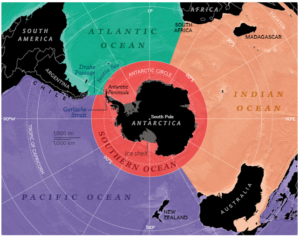In news
Recently, the National Geographic Society named ‘Southern Ocean’ as world’s 5th ocean
Key updates
- With this decision, the Southern Ocean around Antarctica will be added to the list of oceans along with the Atlantic, Pacific, Indian and Arctic oceans.
- On June 8th World Oceans Day, the society announced that it would henceforth be labeling the Southern Ocean as the fifth ocean on its maps of our planet.
- The Southern Ocean has long been recognized by scientists, but because there was no agreement internationally and was not officially recognized.
- National Geographic began making maps in 1915, but the society had only formally recognized just four oceans, which they defined by the continents that bordered them.
- In contrast, the Southern Ocean is defined not by the continents that surround it, but by the Antarctic Circumpolar Current (ACC) that flows from west to east.

- The newest body of water makes it the second-smallest, after the Arctic.
- The ACC flows through all waters that surround Antarctica until about 60 degrees south, except for the Drake Passage and the Scotia Sea, which are both roughly between South America’s Cape Horn and the Antarctic Peninsula.
- The waters of the ACC and therefore most of the Southern Ocean — are colder and slightly less salty than the ocean waters to the north.
- The ACC pulls in water from the Atlantic, Pacific and Indian oceans to help drive a global “conveyor belt” that carries heat around the planet, while the cold dense water of the ACC sinks and helps to store carbon in the deep ocean.
Role of National Geographic society
National Geographic has followed the International Hydrographic Organization (IHO) on marine names. While not directly responsible for determining them, the IHO works with the United Nations Group of Experts on Geographical Names to standardize names on an international scale. The IHO recognized the Southern Ocean in its 1937 guidelines but repealed that designation in 1953, citing controversy.
Names of oceans
- Different names have been given to the oceans based on geographical, navigational, scientific and historical reasons.
- Historically, explorers and geographers have recognized the existence of 4 oceans – Pacific, Atlantic, Indian and Arctic.
- The Antarctic Ocean, also known as the Southern Ocean, is a more recent addition to the list.
- The term ‘ocean’ comes from the Latin word “ōkeanos” which translates to the “great stream encircling the earth’s disc”.
- This was used by the Greeks to describe the single mass of water that they believed surrounded the earth.
- Ōkeanos was used with contrasting reference to the inland waters of the Mediterranean Sea.
National Geographic Society
- It is a global nonprofit organization committed to exploring and protecting our planet.
- It is headquartered in Washington, D.C., United States.
- Founded in 1888, its interests include geography, archaeology, and natural science, the promotion of environmental and historical conservation, and the study of world culture and history
- It is governed by a board of trustees whose 21 members include distinguished educators, business executives, former government officials and conservationists.
- The organization sponsors and funds scientific research and exploration.
The Society’s media arm is National Geographic Partners, a joint venture between The Walt Disney Company and the Society, which publishes a journal, National Geographic in English and nearly 40 local-language editions.
















